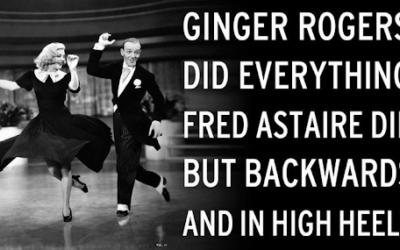Women are good for business. Studies have made it clear that women are excellent leaders, creating “The Woman Effect” to produce meaningful, measurable and often dramatically improved results for companies that sustain a relative gender balance in their leadership team.
But it’s important to recognize that this dynamic isn’t (only) about women. Companies with a leadership presence of women that goes beyond the token (30% or more) create conditions in which women and men react and interact differently — and productively. Women are catalysts for this new, more productive leadership culture as they integrate into the default male-oriented leadership culture, but results are jointly produced.
This dynamic has been related to me anecdotally by business, military, government, nonprofit and academic leaders. It seems that when women and men are in parity roles in groups, men are more polite, more open to ideas and less focused on interpersonal competitiveness, while women are more authoritative, analytically focused and less passive. The resultant dialog reflects these changes as women and men collaborate; more ideas are heard, more perspectives evaluated and, ultimately, better decisions made. Research supports this by finding that gender-balanced groups are smarter. It takes two to tango, and apparently it takes two styles to lead.
This idea of gender partnership runs pretty deeply in the human race, so it should come as no surprise that it’s active in leadership, too. In fact, research says that when leaders master skills traditionally tagged as “masculine” and “feminine,” they are more successful.
But there’s another reason to welcome women into the executive ranks. In the 21st century, there’s no question that our culture and economy demand more of leaders. The new model leader looks more like Starbucks CEO Howard Shultz than Henry Ford or even Steve Jobs. If you distill much of today’s leadership literature, the ideal 21st-century leadership and corporate-culture profile has gender-balanced characteristics:
- Self-aware, flexible and learning
- Driven and innovative
- Plays well with humans and customer and employee oriented
- Results oriented and analytically informed
See the pattern? As individuals and groups, the world is calling us to blend the gifts and abilities both genders bring to leadership and to learn from one another. Leaders are often called upon to cultivate versatility and character, and, in many ways, gender-balanced leadership style is the recipe.
What to do about this? The research has given rise to many initiatives, organizations and further research encouraging an increase in the number of women on boards of directors. I support these efforts, but I don’t think putting more women on boards is the starting point; it’s the ending point. When The Woman Effect has been activated in an organization, gender-balanced leadership styles and gender-partnered teams will be operating at every level, every project and in every meeting, from bottom to top.
When this is the case, women will naturally be recognized and groomed for board positions because companies have integrated their leadership strengths into their culture and value these talents in women and men they bring to the executive suite. If your company is doing this, I’d like to know about it and profile you.
This post originally appeared on SmartBlog on Leadership. For more insights on business leadership, sign up for SmartBrief on Leadership.
Guide to Women in Leadership
Organizations with women in their executive suites regularly out-perform others. Yet rising female executives (and their mentors) are frustrated at how hard it is to break through the glass ceiling. In this extensive guide, Executive Coach Dana Theus shares her tried and true strategies to help women excel into higher levels of leadership and achieve their executive potential.






